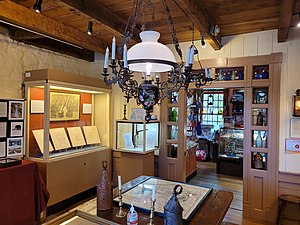United States historic place
| Vander Ende–Onderdonk House Site | |
| U.S. National Register of Historic Places | |
| New York City Landmark No. 1923 | |
 | |
   | |
| Location | 1820 Flushing Avenue, Ridgewood, New York |
|---|---|
| Coordinates | 40°42′40″N 73°55′12″W / 40.71111°N 73.92000°W / 40.71111; -73.92000 |
| Area | 2 acres (0.81 ha) |
| Built | 1661 |
| NRHP reference No. | 77000975 |
| NYCL No. | 1923 |
| Significant dates | |
| Added to NRHP | January 31, 1977 |
| Designated NYCL | March 21, 1995 |
The Vander Ende–Onderdonk House, also known as the Van Nanda House, is a historic house at 1820 Flushing Avenue in Ridgewood, Queens, New York City. It is the oldest Dutch Colonial stone house in New York City.
The house is owned by the Greater Ridgewood Historical Society. Much of the house now functions as a museum of earlier eras of New York.
History
The original house on the site was built in 1661 by Hendrick Barents Smidt, from land that was granted to him by Peter Stuyvesant. Another part of the structure, expanding from the original house, was built in 1709 by Paulus Vander Ende. The house was inherited by Paulus's son Frederik, who changed his last name to Van Nanda; Frederik's daughter Jane and his son-in-law Moses Beadel inherited the house next in 1769. The house was mentioned in a 1769 survey that established the boundary between Kings and Queens counties and may have been largely constructed around this time; it is very close to the border. The Onderdonk family acquired the property in 1821. The old address was 1416 Flushing Avenue. The property once included 100 acres of farmland, but land was gradually sold until the property was reduced to under two acres.
In 1975, the house suffered a serious fire that destroyed many of its wooden elements. The house was added to the National Register of Historic Places in 1977. The building was repaired in the early 1980s with the aid of half a million dollars of federal funds; due to its historic status, it was rebuilt using the original tools and styles of the colonial era. It was designated a landmark by the New York City Landmarks Preservation Commission in 1995.
In 2001, the Arbitration Rock was believed to be rediscovered, an ancient rock used to measure property claims and deeds in the late 1700s and early 1800s. The Rock was moved in August 2001 to the backyard of the Vander Ende-Onderdonk House.
Gallery
-
A 1977 marker commemorating the NRHP designation
-
 Exterior of the Vander Ende–Onderdonk House in 2022
Exterior of the Vander Ende–Onderdonk House in 2022
-
 Attic of the Vander Ende–Onderdonk House in 2022
Attic of the Vander Ende–Onderdonk House in 2022
-
 A 1st floor room of the Vander Ende–Onderdonk House, now used as museum space
A 1st floor room of the Vander Ende–Onderdonk House, now used as museum space
See also
- List of the oldest buildings in New York
- List of New York City Designated Landmarks in Queens
- National Register of Historic Places listings in Queens County, New York
References
- "National Register Information System". National Register of Historic Places. National Park Service. March 13, 2009.
- ^ "The Vander Ende-Onderdonk House". Greater Ridgewood Historical Society. Archived from the original on November 4, 2010. Retrieved October 15, 2010.
- ^ Besonen, Julie (March 6, 2014). "A Hobbit House, With Chickens". The New York Times. Retrieved June 26, 2022.
- Bridges, Sarah T. (August 1976). "National Register of Historic Places Registration: Vander Ende–Onderdonk House". New York State Office of Parks, Recreation and Historic Preservation. Retrieved January 16, 2011.
- "A Ridgewood farmhouse that harvested history: Our Neighborhood: The Way it Was". QNS.com. December 18, 2021 . Retrieved June 27, 2022.
- ^ "Adrian and Ann Wyckoff Onderdonk House Designation Report" (PDF). New York City Landmarks Preservation Commission. Retrieved October 10, 2013.
- Sherman, Beth (March 24, 1985). "If You're Thinking of Living in Ridgewood". The New York Times. Retrieved June 26, 2022.
- Lippincott, E. E. (September 9, 2001). "NEIGHBORHOOD REPORT: RIDGEWOOD; Rolling Rock Gathers Anger". The New York Times. Retrieved June 26, 2022.
- Kershaw, Sarah (May 16, 2002). "It's a Boulder, All Right, But Was It Once a Border?; Marker Lost to History Is Found (Maybe)". The New York Times. Retrieved June 26, 2022.
External links
- Vander Ende–Onderdonk House – official site
| New York City historic sites | |
|---|---|
| National Register | |
| City Landmarks | |
